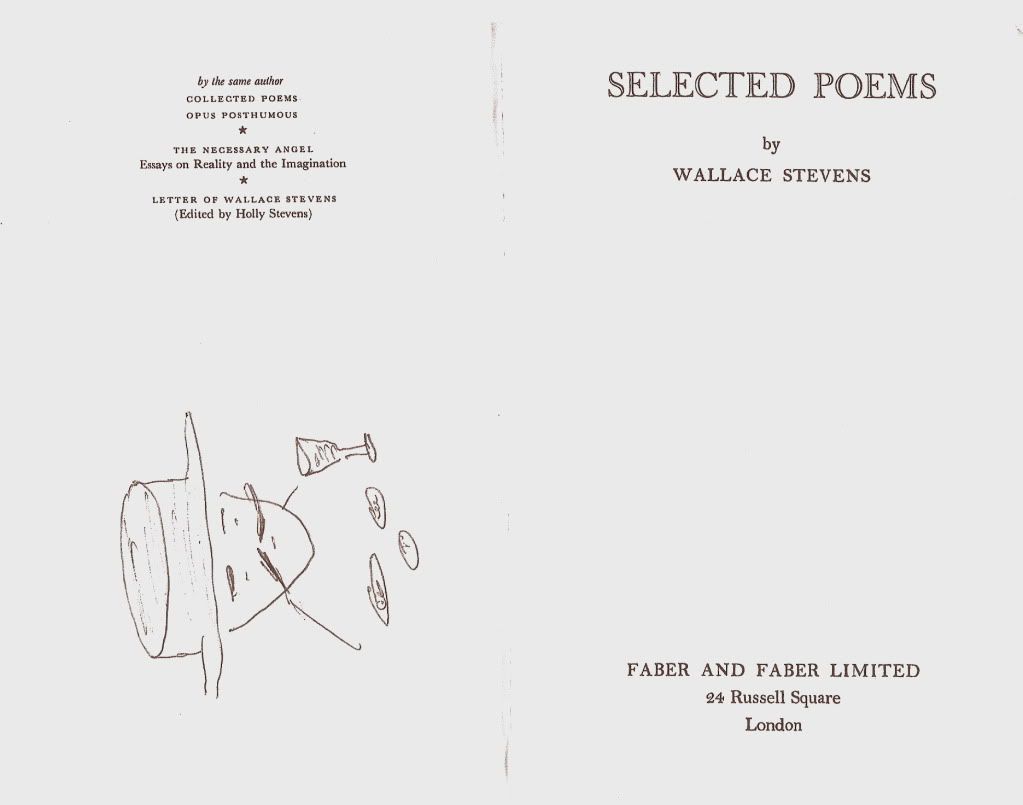
A drawing by Martin Bell in my copy of the selected Stevens
To know that the balance does not quite rest,
That the mask is strange, however like.
– Wallace Stevens, The Man With the Blue Guitar
… They told me you had been to her,
And mentioned me to him:
She gave me a good character,
But said I could not swim.
He sent them word I had not gone
(We know it to be true):
If she should push the matter on,
What would become of you?
I gave her one, they gave him two,
You gave us three or more;
They all returned from him to you,
Though they were mine before.
If I or she should chance to be
Involved in this affair,
He trusts to you to set them free
Exactly as we were…
- Lewis Carroll
It is a pretty well accepted commonplace that the figure ‘I’ in a poem is not to be confused with the author in the evidential sense. Or rather not entirely confused - or maybe just a little confused.
But the person writing the poem is present as a voice or voices. The voice (s) is / are assumed. It is not exactly the author’s speaking voice that speaks but a voice in a poem.
Furthermore, it is likely that the poem will have a number of actors. One will do, but maybe more. One of these actors may well be an I but it need not be. It could be any of the available pronouns, or almost any. Certainly, a you could be an I in disguise, as could a she or he. One might choose to speak as oneself. Alternatively we could assume a collective voice. It is certainly something we could do. It helps to cut a figure.
But then the I itself (myself?) could be quite clearly someone else, as in a dramatic monologue. Imagination spreads across identities. Imagination is the key, after all, isn’t it?
A figure could appear as a name, a more specific invitation, a Tom or a Joan or indeed a full formal name like, say, Reuben Bright. A figure might be simply an office – a job, a role, a function.
A figure could certainly be they or them, but it is hard for an I to become one of them, unless the they is read as a form of we.
Frankly, we hardly know the I outside the poem, so it is no surprise when I finds itself dispersed, distilled, dissected, spoken for, turned round to face itself, or, like Bottom, translated.

3 comments:
Your lovely essay but, tangentially to your v interesting thoughts, I must show you/lend you the most exquisite 1977 limited edition of David Hockney's ethchings (copper plate)"The Blue Guitar" with Wallace Stevens' "The Man with the Blue Guitar". The title: "The Blue Guitar Etchings by David Hockney Who Was Inspired by Wallace Stevens Who Was Inspired by Pablo Picasso". I bet you know the Petersburg Press (London and New York). You probably know the volume. But it was a generous gift a year ago from a painter friend who knows my love of Stevens............Happy to lend.
It may be necessary to cutting a figure. It is looking at I or you or he or she or we or they with imaginative detachment.
I'd love to see that, Diane.
JLK - Thank you. I am looking to think about imaginative detachment in the next post.
Post a Comment